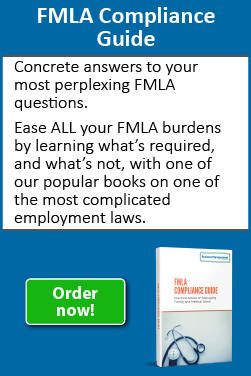COVID-19 long-haulers will likely be eligible for intermittent FMLA leave
Managing intermittent FMLA leave is about to get much more complicated thanks to COVID-19 and so-called “long-haulers.” Most people who become infected with the virus recover quickly and are back to work in two weeks. However, some may remain sick for considerably longer, recovering slowly even if they avoid hospitalization. A smaller number end up in the hospital for weeks. A few die.
Now that the pandemic has raged for over a year, doctors and scientists are seeing a worrisome trend. Those who recover from a COVID-19 infection may have lingering physical and psychological complications. These are the long-haulers.
When they do try to return to work, their employers may have to make adjustments. Among those is providing intermittent leave under the FMLA.
Intermittent leave
Private-sector employers with 50 or more workers and all public employers must provide eligible workers with FMLA leave. That includes leave taken for one’s personal illness when unable to perform the essential functions of one’s job. Illness includes certain chronic conditions that flare up from time to time or require regular maintenance treatments or doctor visits. Employees with 12 months of service who have worked at least 1,250 hours during the past 12 months are eligible. Thus, employees who average about 24 hours per week and up are eligible. Leave can be taken either in full-time blocks or intermittently.
Intermittent leave is the most difficult to manage because of its unpredictable nature. For example, employees with lupus or multiple sclerosis may go through periods of severe disability requiring weeks off. During remissions, the same employees might only need intermittent leave for a few hours or a few days for medical appointments. While employers might have a general idea of how often the employee will need off, exactly when is unknown.
COVID-19 long-haulers
There have been over 26.7 million confirmed COVID-19 cases diagnosed in the United States since the first case reported. According to the CDC, the total number of symptomatic cases is likely higher — over 70 million. Those numbers are expected to grow even as the nation vaccinates against the virus and the pandemic eventually ends. And millions of long-haulers who suffer long-term effects from their bout with the virus will need help.
How many Americans will be long-haulers? An exact figure isn’t yet known. Recent studies hint at how many will be permanently disabled and thus need intermittent leave when they return to work. The most recent estimate is ten percent become long-haulers. These patients include individuals who were severely ill and individuals with mild infections. Many are in their prime working years. According to Johns Hopkins, among patients 18-34 years old who had no preexisting conditions when they got sick, 20 percent are long-haulers.
 What conditions do they suffer from?
What conditions do they suffer from?
The most common symptoms are:
- Coughing and shortness of breath;
- Intense and ongoing fatigue – dubbed post-viral fatigue syndrome;
- Body aches and joint pain;
- Loss of taste and smell;
- Insomnia and sleep problems; and
- Headaches and something referred to as “brain fog”.
There are also other, more seriously debilitating consequences for some survivors like:
- New Type 2 Diabetes;
- Newly triggered auto-immune disorders like lupus;
- Depression and anxiety disorders;
- Heart arrhythmias and myocarditis; and
- Blood clotting disorders and potential strokes.
Bottom line: Working-age long-haulers may need employer support to return to work, including intermittent leave. And their various medical ailments may mean increased medical and insurance costs.
COVID-19 long-haulers may have ADA protection too
Generally, when we talk about intermittent leave, we’re focused on the FMLA. But many — if not most — of the anticipated long-haulers will also be disabled. That means they’re also covered by the Americans with Disabilities Act (ADA) and entitled to reasonable accommodations too. Employers will have to come up with ways to help long-haulers readjust to the workplace.
Reassignment
Those long-haulers who can’t perform all the essential functions of their jobs may have to be reassigned to open positions. For example, someone newly diagnosed with post-COVID heart maladies may have lifting restrictions. Those restrictions would trigger reassignment to a more sedentary job.
Job modification
Another long-hauler option is modifying the job the worker already holds. That’s a classic reasonable accommodation. Modifications can include everything from a redesigned workplace for physical disabilities to schedule changes. For example, a long-hauler suffering from insomnia and depression might benefit from later start dates or part-time work.
More intermittent leave than the FMLA provides
Intermittent leave under the FMLA is limited to the equivalent of 12 weeks of unpaid time off. Once the leave is used up, the employee must requalify by meeting the 1250 hour service requirement again. But there is another way for a COVID-19 long-hauler to qualify for more — and indefinite — intermittent leave. He can simply request a reasonable accommodation under the ADA.
One of those reasonable accommodations is taking intermittent leave. New employees who haven’t earned time off and long-time employees who have used up all leave are both entitled to intermittent leave as a reasonable accommodation through the ADA, if disabled. Thus, even a newly hired COVID-19 long-hauler may immediately be eligible for intermittent leave. While FMLA intermittent leave is different from ADA intermittent leave, both can benefit COVID-19 long haulers who need time off.
In a recent federal case, the EEOC made it clear that disabled workers — which will often include long-haulers — are entitled to ADA intermittent leave. The EEOC sued a food products manufacturer, alleging it fired a worker instead of making reasonable accommodations for her disabilities. The worker developed several disabilities during her tenure, including COPD, chronic bronchitis, a chronic bleeding ulcer, and high blood pressure. These are all conditions that are common among long-haulers. Her disabilities required treatment and hospitalization at least five times. Each time, she asked for intermittent leave.
The employer refused to discuss accommodations and instead tallied up infraction points under its strict attendance policy. She was fired after hitting the maximum attendance points. The EEOC sued, telling the court the use of intermittent medical leave for treatment of a disability is widely recognized as a reasonable accommodation.” The lawsuit is a clear indication that the EEOC will pursue employers who don’t accommodate long-haulers with intermittent leave.
Long-haulers and workers’ comp
A small subset of long-haulers may qualify for workers’ compensation benefits in states that allow it. For example, many medical providers can easily show their illness was triggered by workplace exposure. States are increasingly easing the rules for proving that a COVID-19 infection was work-acquired. For lingering illness, that may mean millions of new workers’ compensation claims.







